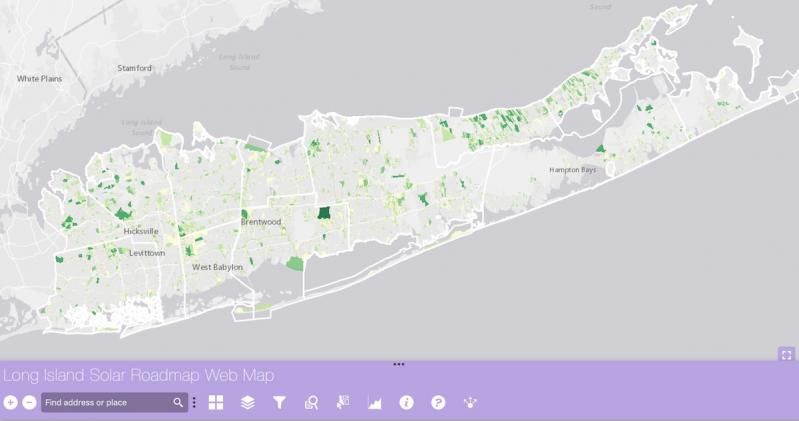Long Island could generate more electricity than it consumes with mid to large-scale solar installations on developed sites, including parking lots, commercial building rooftops, and capped landfills, a new report says.
According to the Long Island Solar Roadmap, a study and interactive map jointly published by the Nature Conservancy and Defenders of Wildlife, the Island has enough such "low-impact" siting potential to host nearly 19,500 megawatts of solar capacity in the form of mid to large-scale installations, defined as 250 kilowatts or larger. Approximately one-third of that total could be on parking lots and rooftops, the remainder from ground-mounted installations on already-impacted land.
The report asserts that developing just one-quarter of such low-impact sites would provide the Island's electricity needs, while generating more than 10,000 jobs in the fast-growing solar sector and some $10 billion in economic benefits. It also demonstrates that mid to large-scale solar farms can be sited in areas of high population density, avoiding detrimental impact to farmlands or natural areas critical for wildlife and water-quality protection.
Building solar on low-impact sites also reduces the potential for land-use conflicts and community opposition, according to the study, while decreasing project cost and permitting times.
An interactive map depicting the low-impact potential for solar installations on Long Island is at solarroadmap.org/maps.
The Town of East Hampton has the potential to host as much as 470 megawatts of solar capacity, enough to power more than 117,700 residences, according to the report. The town has 2.1 square miles of potential low-impact sites, most of it for ground-based installations on previously altered or disturbed areas, but also for parking lots and rooftops.
Development as proposed by the map would help New York State achieve mandates established by the 2019 Climate Leadership and Community Protection Act, which calls for 70 percent of the state's electricity to come from renewable sources by 2030, and 100 percent zero-emission electricity by 2040.
The map and report are aimed at local officials and planners, as well as developers and private property owners. It reflects input from state, county, and local government officials, including East Hampton's; the solar industry, farmers, environmental and community organizations, the Long Island Power Authority, businesses, and academic institutions.
Long Island has the state's highest concentration of residential solar rooftop installations, but a buildout of mid to large-scale solar installations would bring clean energy to more residents, including renters, and businesses. The largest existing arrays on the Island are a 32-megawatt array at Brookhaven National Laboratory, a 24.9-megawatt array in Shoreham, and a 20-megawatt array in Calverton. The Accabonac Solar plant, a 1.6-megawatt array on a decommissioned, town-owned brush dump in East Hampton, produces electricity sufficient to power 136 residences.
"We're hoping the Roadmap is a conversation starter about the potential for solar across Long Island, for a lot of different stakeholders," said Jessica Price, renewable energy strategy lead for the Nature Conservancy. "Addressing climate change is an all-hands-on-deck situation. We're hoping this report and the online maps will move folks to look and say, what role can I play in helping the renewable-energy transition? Solar is one of the more personally accessible."
Gordian Raacke of Renewable Energy Long Island in East Hampton called the Roadmap "a tool that can be used by solar developers, by towns, by anyone who wants to develop solar. It's specifically designed to identify low-impact sites, sites that have either already been cleared or been used for another purpose, and that could at least theoretically be converted to solar. It's very useful, and the first time we've had this kind of a tool."
The Roadmap does not reflect the cost of land, which Mr. Raacke said could make acquisition for mid and large-scale solar installations on privately-owned land unrealistic on the South Fork. Also, said Kim Shaw, director of the East Hampton Natural Resources Department, "We have a lot of land that's preserved, but because of the procurement process, there's a lot prohibiting solar on those properties." But low-impact solar — situated on already-developed areas such as rooftops and parking lots — would not necessarily require the acquisition of large tracts.
The new report is not a pitch for solar to the exclusion of other forms of renewable energy, Mr. Raacke noted. "We would always want a diversified portfolio of energy sources. We want renewable sources that work in the middle of the night. Solar can't. We want renewables sources that peak at noon. Solar can."




